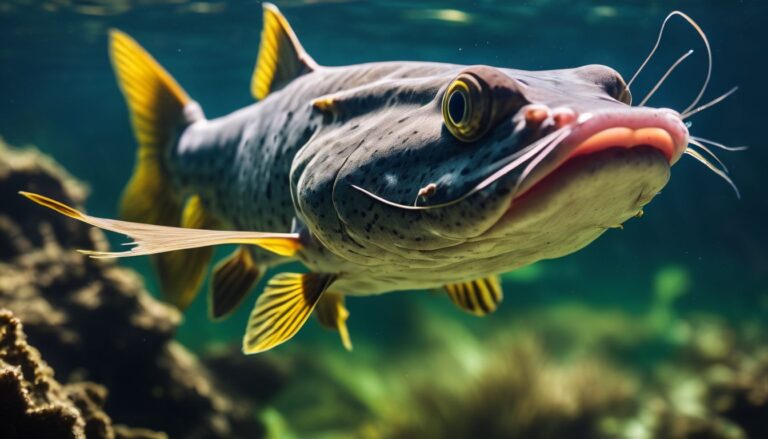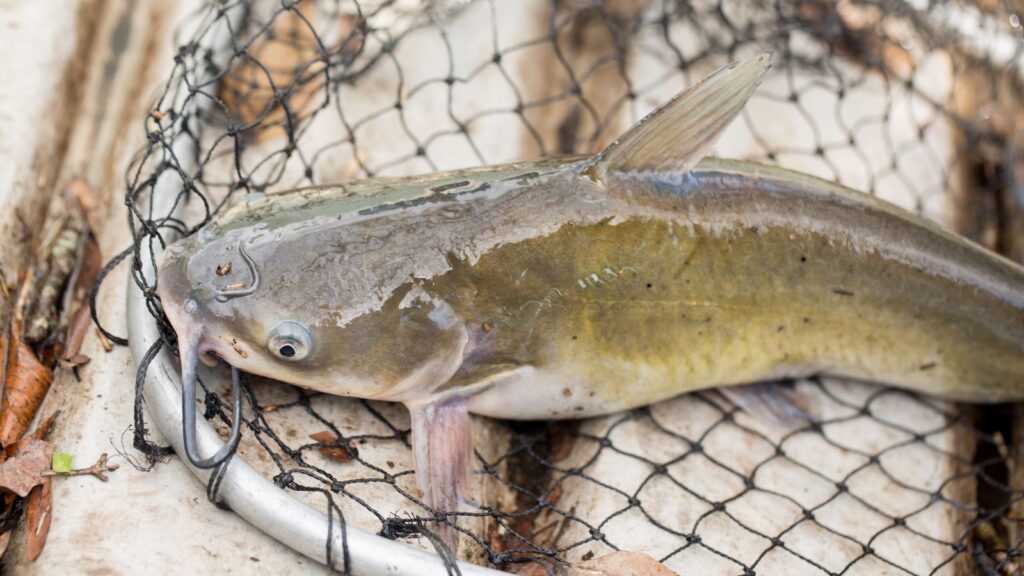
Diving into the world of freshwater fishing can leave you wondering about the different species and their unique characteristics. Did you know flathead catfish, a popular game fish, can grow up to 100 pounds? This comprehensive guide will unravel everything you need to understand about this fascinating creature – from its physical attributes and habitat to conservation concerns and tips for enthusiasts.
Ready for an underwater adventure?
Key Takeaways
- Flat-head catfish are fascinating game fish that can reach impressive sizes, growing up to 3 – 4 feet in length and weighing over 100 pounds.
- They have unique physical characteristics like a flattened head and tubular body, as well as mottled coloration that helps them blend into their surroundings.
- Flathead catfish prefer deep streams, rivers, canals, and lakes as their habitats and are known for their predatory nature.
- Conservation efforts are being made to address the environmental concerns surrounding flathead catfish populations and prevent their spread in certain regions.
Taxonomy and Species Diversity of Flat-head Catfish
Flathead catfish belong to the genus Pylodictis and are known for their unique physical characteristics and adaptations. These fish have a flattened head, tubular body, and mottled coloration that helps them blend in with their surroundings.
Overview of flat-head catfish species
Flathead catfish are a fascinating species, prized for their unique look and large size. Known as game fish, they can grow up to an impressive 3-4 feet in length and tip the scales at over 100 pounds.
With a distinctive flattened head and tubular body, their appearance sets them apart from other types of catfish. They sport a mottled coloration that helps them blend into their natural habitats of deep streams, rivers, canals, and lakes.
Unlike most fish species, flatheads lead solitary lives and aren’t capable of breeding in captivity. But don’t be fooled by these laid-back loners; young flatheads have quite an appetite for aquatic insect larvae! However, as they mature this diet shifts making them one of the top predators in many freshwater ecosystems due to their opportunistic feeding habits.
Physical characteristics and adaptations of flat-head catfish
The flathead catfish is a fascinating species known for its distinct physical characteristics and adaptations. With its flattened head and tubular body, it has a unique appearance that sets it apart from other catfish species.
The mottled coloration of the flathead catfish helps it blend in with its surroundings, making it an effective predator in its freshwater habitats. These fish can grow to impressive lengths of 3 to 4 feet and weigh over 100 pounds, showcasing their size and strength.
They have strong jaws and sharp teeth, allowing them to catch and devour their prey with ease. Additionally, flathead catfish are well-suited for life in reservoirs as they can adapt to various water conditions, making them highly adaptable creatures.
Flathead catfish are not only interesting due to their physical characteristics but also because of their ability to thrive in different environments. Their unique adaptations make them successful predators in streams, rivers, canals, and lakes where they reside.
These solitary fish have superior meat quality which makes them popular among anglers engaging in recreational fishing or commercial fishing activities. Furthermore, the invasive nature of some populations of flathead catfish poses challenges for native fish populations and ecosystems as a whole.
Habitat and Distribution of Flat-head Catfish
Flathead catfish are native to the Mississippi, Missouri, and Ohio River basins in North America. They prefer slow-moving rivers and lakes with deep pools and plenty of cover such as fallen trees or submerged vegetation.
Flathead catfish can also be found in reservoirs, ponds, and even coastal estuaries.
Natural habitat of flat-head catfish
Flathead catfish are native to North America and can be found in a variety of freshwater habitats. They prefer deep streams, rivers, canals, and lakes as their natural habitat. These fish are well-adapted for living in these environments with their flattened head and tubular body shape.
Flathead catfish also have mottled coloration that helps them blend into their surroundings. They are predatory fish that feed on a variety of prey including other fish, crustaceans, and insects.
Their ability to thrive in different waterways makes them a popular species for recreational and commercial fishing.
Geographical distribution of flat-head catfish
Flathead catfish can be found in a wide range of habitats across North America. They are native to the Great Lakes region and northern Mexico, but have been introduced to many other areas as well.
These invasive fish have adapted well to various freshwater environments, including streams, rivers, canals, and lakes. They thrive in deep water with plenty of cover like fallen logs or submerged vegetation.
Whether you’re living off the grid near a lake or exploring remote waterways, there’s a good chance you’ll come across these fascinating creatures.
Reproduction and Life Cycle of Flat-head Catfish
Flathead catfish are known for their unique reproductive behaviors and interesting life cycle.
Reproductive behaviors of flat-head catfish
Flathead catfish are known for their unique reproductive behaviors. During the breeding season, which usually occurs in late spring or early summer, male flatheads excavate nest cavities in submerged logs or debris.
These nests can be quite large and may measure up to several feet in diameter. Once the nest is ready, females lay their eggs inside it while males guard and defend the nest fiercely.
After hatching, the young flatheads stay close to the nest until they are capable of swimming on their own. This nesting behavior ensures high survival rates for the offspring and contributes to maintaining healthy populations of flathead catfish in their natural habitats.
Life cycle and growth of flat-head catfish
Flathead catfish go through a remarkable life cycle and can grow to impressive sizes. These fish start their lives as tiny larvae, feeding on aquatic insect larvae in the safety of shallow waters.
As they grow, they become more aggressive predators, preying on smaller fish and other aquatic organisms. Flathead catfish can reach lengths of 3 to 4 feet and weigh over 100 pounds! They prefer deep streams, rivers, canals, and lakes as their habitats, where they continue to grow and thrive throughout their lives.
It’s fascinating how these fish start small but end up becoming massive creatures in the freshwater ecosystems they inhabit.
Interaction with Humans and Environmental Concerns
Flathead catfish play a significant role in aquaculture and fisheries, making them highly valued by both recreational and commercial fishermen. Additionally, there are ongoing efforts to conserve flathead catfish populations and address environmental concerns surrounding their invasive nature.
Importance of flat-head catfish in aquaculture and fisheries
Flathead catfish play a crucial role in aquaculture and fisheries. These fish are highly valued for their meat, which is known for its superior quality and taste. They are considered a prized catch by recreational anglers and are often targeted for commercial fishing as well.
With their large size, reaching up to 3 to 4 feet in length and over 100 pounds in weight, flathead catfish provide a significant food source for people living off the grid. Additionally, they contribute to the balance of aquatic ecosystems by controlling populations of smaller fish species.
Overall, the importance of flathead catfish in both aquaculture and fisheries cannot be overstated.
Conservation efforts and environmental concerns related to flat-head catfish
Conservation efforts are being made to address the environmental concerns related to flathead catfish. In regions where they have become invasive, steps are being taken to prevent their spread and protect native fish populations.
Efforts include implementing regulations on fishing limits and promoting catch-and-release practices. Additionally, research is ongoing to better understand the impact of flathead catfish on ecosystems and develop strategies for managing their populations in a sustainable manner.
It is important for individuals and communities to be aware of these concerns and support conservation initiatives to ensure the long-term health of our waterways.
Tips and Fun Facts for Flat-head Catfish Enthusiasts
Learn tips for catching flathead catfish, discover interesting facts and myths about these fascinating creatures.
Tips for catching flat-head catfish

To increase your chances of catching flathead catfish, try using live bait such as small fish or crayfish. Cast your line near submerged logs or other structures where the catfish like to hide.
Keep in mind that these fish are more active at night, so consider fishing during the evening or early morning hours. When you feel a bite, give the fish some time before setting the hook to ensure a solid connection.
Remember to use heavy-duty tackle and be prepared for a fight, as flathead catfish are known for their strength and fighting ability.
Interesting facts and myths about flat-head catfish
Flathead catfish are fascinating creatures with some interesting facts and myths surrounding them. Did you know that these fish can grow up to an impressive 3 to 4 feet in length and weigh over 100 pounds? That’s one big fish! Another interesting fact is that flathead catfish are known for their predatory nature, feeding on anything from fish to crayfish.
They have a unique adaptation – a flattened head and tubular body – which helps them navigate through their freshwater habitats.
Now let’s debunk a common myth about flathead catfish: they cannot be bred in captivity. This means that if you want to catch or consume these impressive fish, you’ll have to rely on catching them in the wild.
However, there are also some misconceptions about flatheads being invasive species in certain regions. While it’s true that they have been introduced into new habitats outside of their natural range, the origin and spread of flathead catfish still remains a topic of research and study.
Conclusion
In conclusion, the flathead catfish is truly a fascinating species. With its large size, unique appearance, and preference for deep streams and lakes, it has captured the attention of many outdoor enthusiasts.
Whether you’re interested in recreational fishing or conservation efforts, there’s much to learn about these impressive fish. Despite being an invasive species in some areas, they continue to thrive and adapt in various waterways.
So whether you’re an off-grid living enthusiast or simply intrigued by freshwater fish habitats, exploring the world of flathead catfish is sure to be an exciting adventure.
FAQs
1. Where can I find flathead catfish?
Flathead catfish are typically found in freshwater bodies such as rivers, lakes, and reservoirs with slow-moving or stagnant water.
2. What do flathead catfish eat?
Flathead catfish are opportunistic predators and eat a variety of food including fish, crayfish, frogs, insects, and even small mammals.
3. How big can flathead catfish grow?
Flathead catfish have the potential to grow very large, with some individuals reaching lengths of over 4 feet and weighing more than 100 pounds.
4. Are flathead catfish dangerous?
While flathead catfish are not typically aggressive towards humans, they have sharp spines on their pectoral and dorsal fins that can cause painful injuries if handled improperly.